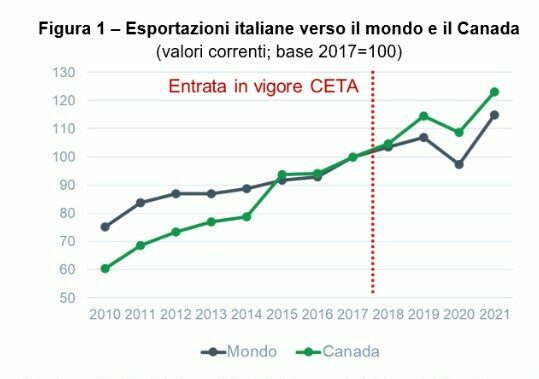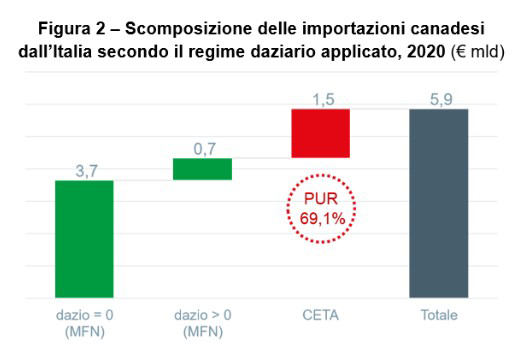How is the trade between Italy and Canada with Ceta going? Sace report

Five years after the entry into force of Ceta, the free trade agreement between the EU and Canada, here are the data on Italian trade to Ottawa according to the report of the Sace research office
On September 21, 2021, the CETA, the free trade agreement between the European Union and Canada, entered into force in a provisional form: it has not yet been ratified by the parliaments of all European member states, including Italy. .
CETA – short for Comprehensive Economic and Trade Agreement – eliminates almost the entirety of customs duties between the European Union and Canada, as well as providing provisions to facilitate investments and allow the mutual participation of companies in public tenders.
THE OPPOSITION OF SALVINI AND DI MAIO
CETA was heavily opposed in Italy by Coldiretti (the farmers' association), as well as by the 5 Star Movement and the Lega. In 2018 Luigi Di Maio, then Minister of Labor and Economic Development, called it a "nefarious treaty" and said that Italian officials abroad who defended the pact would be removed from their posts.
The then Minister of the Interior Matteo Salvini, on the other hand, declared that CETA “legitimizes Italian sounding , the counterfeiting of Italian products. It opens the market to parmesan and mozzarella “, that is, foreign food products that have names similar to the Italian originals to deceive consumers. In reality, as explained at the time by Pagella Politics , "the agreement introduced for the first time, in commercial relations between the EU and Canada, measures aimed at strengthening the protection of typical Italian products and their brands […] thanks to the recognition and the commercial protection in Canadian territory of 143 European Geographical Indications (IIGG), of which 41 are Italian ".
Among the trademarks of origin protected by CETA there are, for example, Parma, San Daniele, Toscano and Modena hams and cheeses such as Parmigiano Reggiano, Asiago, Fontina, Gorgonzola and buffalo mozzarella from Campania.
HOW ARE ITALIAN EXPORTS TO CANADA GOING
On the occasion of the fifth anniversary of the entry into force of the CETA, SACE – the export credit insurance company controlled by the Ministry of Economy – has released a series of data on the trend of trade between Italy and Canada .
CETA, writes SACE, has allowed a “further improvement” of commercial relations between Rome and Ottawa. In 2021, Italian exports to Canada reached 4.8 billion euros. Between 2017 and last year they grew at an annual average of 5.5 percent, one percentage point higher than the average of Italian exports to the world.

In the same period of time, Canada became the tenth non-EU destination for Italian products, gaining four positions. Italy's market share in the country rose from 1.03 to 1.16.
PROVISIONAL DATA FOR 2022: +28.8 PER CENT
In the first half of 2021, Italian exports to Canada grew by 28.8 percent compared to the same period in 2021.
THE PREFERENTIAL REGIME
SACE talks about "good effects of CETA", also due to the preferential PUR (Preference Utilization Rate) regime: it represents – explains the company – "the share of goods actually exported (imported) under the CETA regime on total exports ( import) who would have the right to benefit from it ".
The reduction of duties is not in fact automatic, but subject to compliance with certain requirements such as the rules of preferential origin, which define the conditions under which a good can be considered produced in a country and can special exchange agreements.
IMPORTS AND EXPORTS
In 2020, the last year for which data are available, Italy imported goods from Canada worth 3.7 billion euros. Approximately 60 percent of these are not subject to duties, as required by the Most Favored Nation Clause (MFN); the remainder, on the other hand, falls under the preferential regime of CETA.
In 2020, Italian exports re-entering the CETA regime amounted to 1.5 billion. The PUR was 69.1 percent, much higher than that of European products (55.2 percent) and up compared to previous years.

Commodities with rates above 80 percent include food, ceramic tiles, stone glass materials. On the other hand, the PUR is lower, at around 65 per cent, for various sectors such as textiles, clothing, footwear and means of transport.
“This could reflect the fact that for relatively well monitored supply chains, such as food”, explains SACE, “it is less burdensome to demonstrate preferential origin; on the contrary, for more fragmented supply chains characterized by a high incidence of imported production inputs, it may be more complicated to satisfy the requirements ".
INVESTMENTS
From 2018 to 2021 there was also an increase in Italian direct investments in Canada, with an annual average of 500 million euros compared to 153 million in the 2014-2017 period.
SACE writes that Italian and European companies will be able to take advantage of Canadian infrastructure plans – and in particular that of the province of Québec, from $ 142.5 billion by 2032 – to reap benefits for their businesses.
This is a machine translation from Italian language of a post published on Start Magazine at the URL https://www.startmag.it/economia/accordo-libero-scambio-ue-canada-sace/ on Fri, 09 Sep 2022 07:15:33 +0000.
